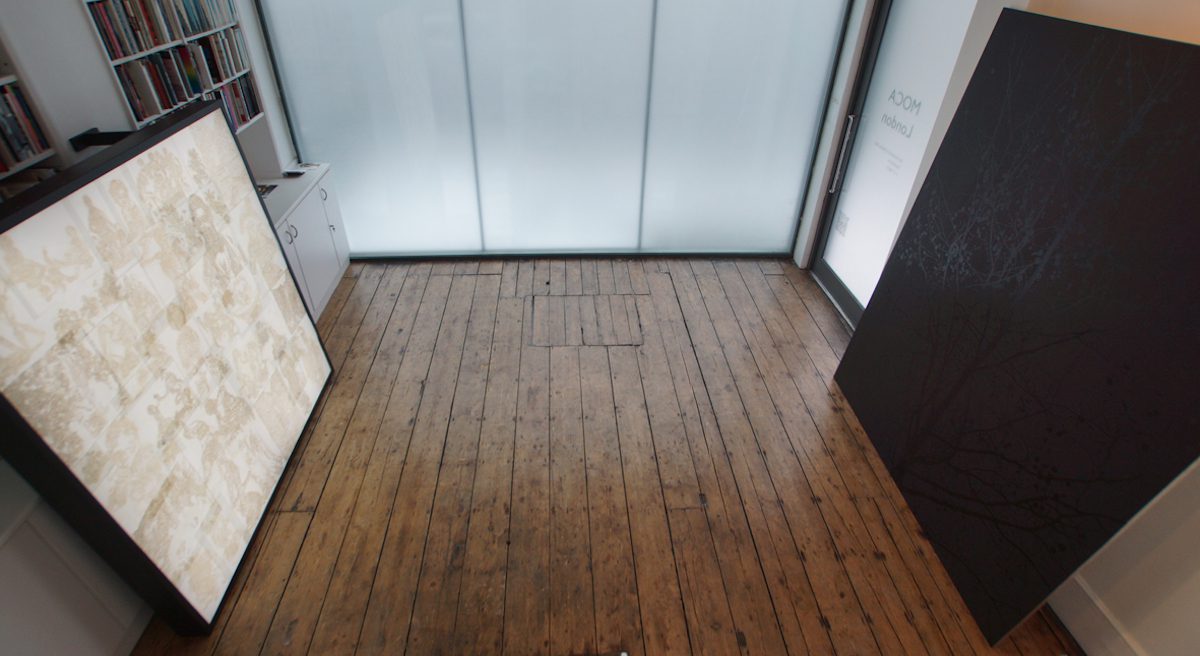Transference is the exhibition currently on at MOCA London, featuring artists Sue Arrowsmith and Mathew Weir. As given from the title of the show; the collaborative exhibition insinuates the artists’ similarities to change and process in both of their art practices, by using a common element in their work: light.
Both artists use technology to create their work – CC
As you enter the gallery, you are confronted with Sue Arrowsmith’s painting titled You can see the dream, and Mathew Weir’s Working drawings, which are drawings placed on a light-box that suggests it to be unfinished and giving insight into his studio practice. The simplistic, but yet precariously placed artworks are on the floor leaning on opposite sides of the room. Pacing back and forth, you are physically immersed in between the dialogue that the artworks reflect off of each other. Speaking with the curator of MOCA London, Roberto Ekholm, he explains the juxtaposition between the works; describing an inclination to monumentalism due to the enormous size of the work, but yet, with a repetitive flow of line that indicate subtle, intimate mark-making details that could easily be missed.
As we continue to compare the works together, we see the appearance of indefinite similarities. The narrative quality is predominantly found in the mark-making; but could also be found in the subtleties such as the tape found in Working drawings that reflect light, just like Arrowsmith’s use of gloss paint in You can see the dream, is one of the subtle details that shift our attention to the connotational use of light. However, light, for the most part, is used as an aid to help create their work. Weir collects imagery found from pottery using a light-box to help trace the images onto polyester drafting film, creating a patch-work of layered imagery, which he later transfers the drawings onto canvas. While Arrowsmith uses a projector to project her photographs on a large scale onto canvas.

The tracing methods used by both artists is one of the obvious links connecting the works together. However, it could be the most notably important of them all, as the use of transferring information in the artists’ work process could easily be the closest suggestion to the term Transference used in psychology; a literal formulation of reproductions of original imagery. This creates a false perception of what our understanding of the subject-matter really is through their work process.
Both artists use technology to create their work. Using a working process that is so precise, but yet both artists intentionally leave traces of fault. You see the tape, and coloured ink used in Working drawings, and fingerprints in You can see the dream. The work seems to link to the classical and traditional as if both artists are reversing time to the past through their working process. It is as if they are referencing a notable painting theory, the Hockney-Falco thesis, and questioning our perception of the past.
The artists are reproducing or re-appropriating an image. The intentional imperfection found in both works embodies the conventional use of themes of nature found in their work, that traditionally reflects questions on the sublime and our mortality. A simplistic, yet poetic reflection on our inevitable desire for perfection.
Words: Chiara Cassar © 2018 Artlyst Photos Courtesy MOCA London and The Artists
Chiara Cassar lives and works in London. Graduated MA Fine Art at Chelsea School of Art. She is an artist and writer.

